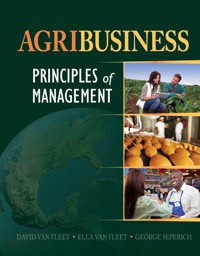The waitress at a local breakfast place asked in her best professional, monotone voice, So, do you
Question:
The waitress at a local breakfast place asked in her best professional, monotone voice, “So, do you want a ‘Pepsi’ with your oatmeal?” She was responding to an article on the page her customer was reading in The Wall Street Journal. The article was about PepsiCo’s purchase of Quaker Oats a decade ago for $13.8 billion and the challenges it faced to boost sales in a very competitive ready-to-eat hot cereal market.
Pepsi-Cola and Quaker Oats may not be a new-wave breakfast, but the idea does illustrate circumstances that arise as a result of corporate acquisitions to boost overall revenue, especially in the agribusiness sector. In fact this demonstrates two important lessons for managers.
The fi rst lesson: It is imperative for a company to clearly differentiate itself from its competitors. A more than casual look at a soft-drink display in the supermarket yields an array of products. Not only are the usual products present (Dr. Pepper, Coca-Cola, Pepsi-Cola, to name the large marketers) but also private label brands under the supermarket chain’s logo and other private labels. This marketing array is exactly what the supermarket chain wants to provide: variety and selection.
The soft-drink industry is very competitive. The top four market-share holders in carbonated beverages are Coca-Cola, Pepsi-Cola, Dr. Pepper Snapple Group, and Cott, in descending order. Combined, these four competitors held 92 percent of the 2011 soft-drink market.
“The big four” beverage makers compete against each other primarily through marketing and packaging.
The primary competition is between Coca-Cola and Pepsi-Cola. Each would prefer that customers purchased their respective products outright, but they fi nd it advantageous to assist smaller competitors with market access to prevent the other brand from gaining more market share. For example, to keep its market share above Pepsi-Cola’s, Coca-Cola bought the rights to distribute Dr. Pepper for the Dr. Pepper Snapple Group for $715 million. Dr. Pepper, in turn, was happy to have access to Coca-Cola’s new touch-screen fountain system. PepsiCo markets Mountain Dew and its diet counterpart for similar reasons.
This highly competitive market environment and the need to differentiate introduce the second point that managers must understand: The necessity to differentiate may lead to a need to master a very different market category. This category may be out of the differentiator’s area of expertise. Thus, to market Quaker Oats products, PepsiCo not only must be competitive in non-alcoholic beverage category (carbonated CHAPTER 5
• The Competitive Environment 107 Copyright 2013 Cengage Learning. All Rights Reserved. May not be copied, scanned, or duplicated, in whole or in part. Due to electronic rights, some third party content may be suppressed from the eBook and/or eChapter(s).
Editorial review has deemed that any suppressed content does not materially affect the overall learning experience. Cengage Learning reserves the right to remove additional content at any time if subsequent rights restrictions beverages, bottled water, sports drinks, fruit drinks, energy and other drinks) but also hot, ready-to-eat cereal products. Certainly it will bring to PepsiCo’s bottom line some revenues that are not available to Coca-Cola Inc., but yet another competitive product category in which to compete. While Quaker Foods has the top spot in its market category over two private-label brands (Cream of Wheat and Bob’s Red Mill), it has been a weak spot for PepsiCo.
Mastery of a competitive environment is an easy mantra to express but difficult to achieve. Mastery is even more difficult when it involves several very different product categories.
Sometimes competition has unintended consequences for the competitors. Consider the case for Cott, one of the top four companies mentioned above. This Canadian company gained entry into the carbonated beverage category at a time when many supermarkets were looking for a carbonated beverage that was a “level above” the standard supermarket private label or generic brand to attract customers away from Coke and Pepsi. Cott was the supermarket’s answer. Unfortunately for the supermarkets, Coca-Cola and Pepsi-Cola were so effective at their trade that another stand-alone competitor was introduced to the carbonated beverage category.
QUESTIONS
1. Assuming that supermarkets are in business to sell whatever consumers want to buy, why do you think supermarkets wanted another beverage competitor to attract customers away from Coke and Pepsi?
2. Assuming that PepsiCo was in business to provide carbonated beverages to a market that consumes its lowest amount of that product at breakfast time, what could possibly have persuaded PepsiCo to get into the ready-to-eat hot cereal breakfast market?
3. Why does competition beget competitors? Under what circumstances may this not be true?
Step by Step Answer:

Agribusiness Principles Of Management
ISBN: 9781285952352,9781285947839
1st Edition
Authors: David Van Fleet, Ella Van Fleet, George J. Seperich





